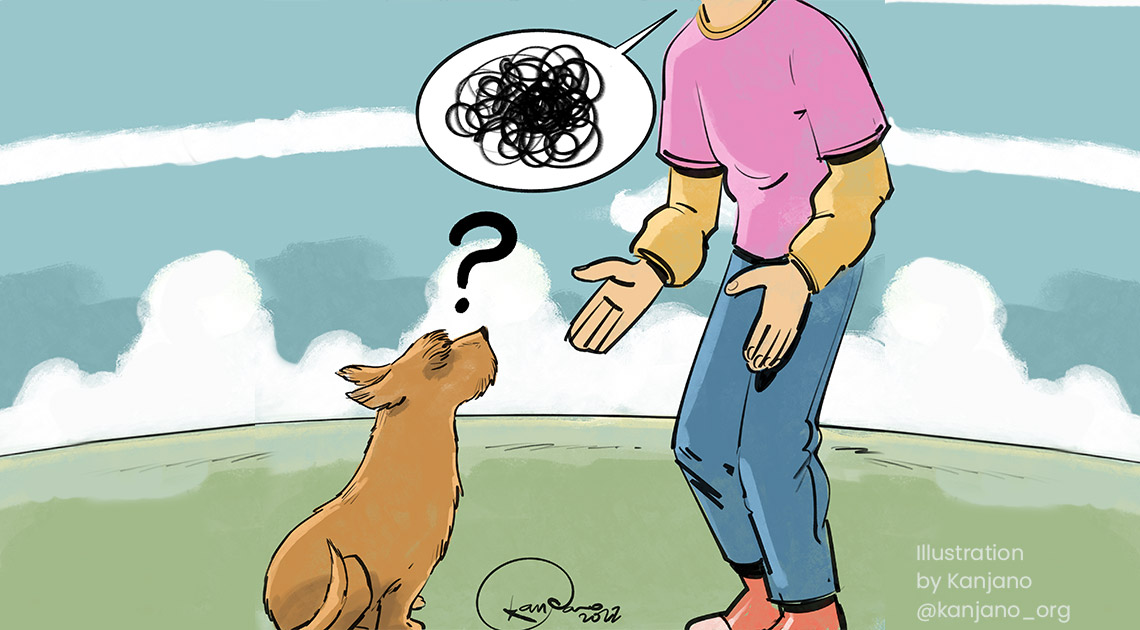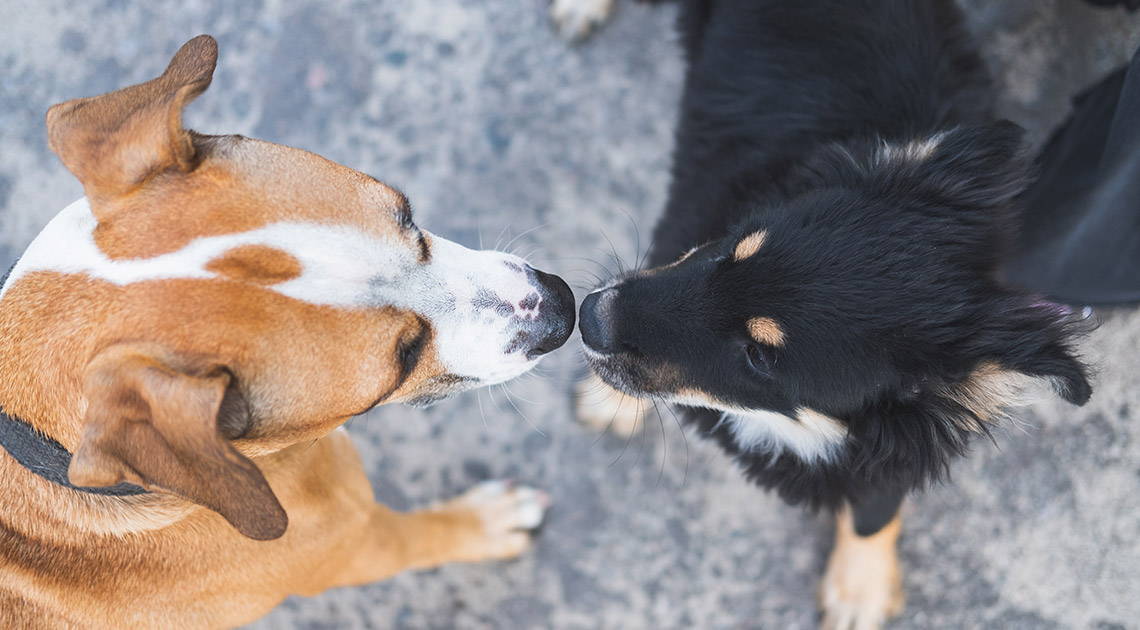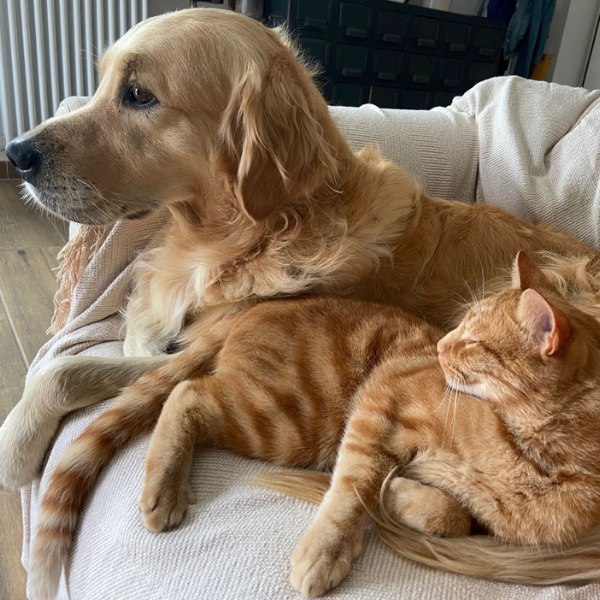Dog and body language. The rules to understand each other better!

by Dunia Rahwan
The Magic Language of the Body
The vast majority of relationship problems between men and dogs stem from a deep communication misunderstanding. We do not comprehend them, and we make little effort to try, whereas they have been observing and studying us for millennia, and have by now acquired a very refined ability to read our emotions and intentions. Compared to them, we are fools! And this includes those who say, "I've had dogs all my life" or, "I have volunteered in kennels for years". Almost everyone commits a multitude of errors every day when it comes to dog assessment, despite the fact that dogs are so punctual and precise in explaining themselves. We start listening to them when they frighten us by barking, growling, gripping, and even biting. And only then do we suspect the presence of some misunderstanding...
What are you saying?
Humans use their voice to express thoughts, emotions, desires, and to verbalize every concept, even inopportunely, and then use an alien type of communication for dogs. The wonderful thing is how the dog nevertheless understands our verbal language and responds consistently to our requests, for example, when we call him back or ask him to stay still and wait for us. One of a dog's preferred communication channels, however, is its sense of smell, a sense that sees us quite unprepared: with a sniff on the butt or of dog pee it can make a complete screening regarding sex, health, emotional state and who knows what else, while the human nose struggles to discriminate odours, which affect us only when they are particularly unpleasant or intoxicating. By studying the behavior of dogs, I have realized that to help the average owner communicate clearly to the dog, and understand it, I had to focus on other channels of communication.
The emotion is in the voice
Let’s do an experiment and try to say aloud the phrase, "come here", anticipated by the dog's name, using three different emotional tones: neutral, assertive as if an order, and welcoming with a voice that you would use with a newborn. It is clear to the dog that it is receiving three different messages, even if the same words are used, and has a different reaction depending on voice intonation. With the use of a neutral tone, it is likely that your call receives very little interest by the dog, blissfully intent on minding its own business; with the use of an assertive tone, instead, the dog understands that we are angry and prefers to keep away from possible trouble; the welcoming, cheerful and carefree tone, on the contrary, entices the dog to approach by tickling its innate curiosity and its predisposition to rejoin its human. And this happens even if the dog does not know the words "come" and "here" or what they mean together. Exploiting emotional osmosis in verbal communication leads to magnificent collaborative responses, even using words unknown to the dog or another language. 
Let the body talk
Perfect communication between dogs and humans takes place on the proxemic, the science that analyzes messages conveyed by the body, or rather by the position taken with respect to the environment and other individuals, how we move and the distance we take from someone or something. I mean, the dog talks with its body, and it says a lot of things with geometric precision! We humans chat with our body, too, but we pay less attention to this, being more attentive to what we feel and see. But we can learn to express ourselves using proxemics to be clearer in our communication with our dogs, utilizing a channel that suits them. Dogs are excellent observers of our proxemics, and it is a pity that often we would like to say something, but our body expresses the exact opposite, as when recalling a dog after it has been free from its leash. If the dog is moving away from us and we try to call it and go towards it, we are actually telling it that we will reach it, so for the dog it is not necessary to turn around and will continue in its given direction. If, on the contrary, we call him back and, when he looks at us, we go in the opposite direction, we communicate, "I am leaving. Do you want to stay on your own or are you coming too?" And when the relationship works, the dog normally chooses to rejoin its social group.
Chatting with body and movement
When I observe the proxemic communication of dogs, I am constantly astonished, especially when two dogs meet and they appear to be dancers intent on performing complicated choreography. The intentions of the participants, be they dog or people, are clearly understood by the position taken: standing in a head-on position communicates assertiveness and threat, a three-quarter position expresses peaceful and friendly intentions, and a side-on position manifests alliance, interest and willingness to interact. If a dog puts itself behind its human or another dog, however, it is delegating all responsibility. If it intends to protect something or someone, it stands in front, as a barrier, and if it wants to cut off the communication, it turns its back and leaves.
The position of the dog with respect to its environment also has great significance, and I see it every day in my dogs, Vilma and Dustyboy. The old lady of my heart has an insecure character, and for her to relax in unfamiliar environments, she must have her blanket lain on the ground in a quiet place, better protected from the rest of the social group. The wild boar, on the other hand, is a classic Labrador overflowing with confidence and so fearless it can fall asleep on my stomach during a Sunday lunch in a pizzeria frequented by noisy families (a true story).
Another crucial aspect of proxemics is movement, and to understand its scope, try to do a test involving a friend: stand three meters away, then stare him in the eyes and approach him quickly with a straight trajectory until you reach him within a few centimeters. Now ask him if he felt a sense of threat and discomfort. The movement trajectory expresses intentions and is therefore very important in an encounter between strangers. If the frontal trajectory inspires fear, the curvilinear trajectory launches messages of peace: "I have arrived and I have good intentions". The aligning trajectory indicates complicity. The speed of movement also has weight: a calm approach relaxes the interlocutor, but one that is too fast creates worry.

Social distancing
In proxemic communication, distances follow an unwritten law: they are reduced by knowledge and mutual trust. Usually dogs accept physical contact only from friends, with whom they also share a response if they enter into intimacy, but among strangers communication takes place mainly at a distance using proxemics, a system that avoids unnecessary conflicts. Often dogs are in difficulty because of the social distances that are not respected, especially in the city where space is reduced and the strange habit of people approaching dogs to touch them prevails. Let’s put ourselves in their shoes: would we be happy to find ourselves with the frantic hands of a stranger on us? I’m sure not, but for some strange reason we think that dogs, indistinctly all of them, can’t wait to be stroked by the first person who passes by. There are certainly dogs that are more cuddly and sociable, like humans, but more often we, like them, share a good deal of distrust and diffidence that gradually reduces as we get to know each other better.
In the shoes of the bodyguard
With reactive or very fearful dogs, it is crucial to learn to exonerate them from any responsibility towards what arouses their concern through proxemic communication. In fact, when a dog on a leash threatens a fellow dog, a runner or a passer-by, he is usually intimidated and emits more or less aggressive behaviour to keep the problem at a distance and avoid the encounter. This happens when dogs are left alone to deal with difficulties, but if its relationship with its handler is healthy and the dog trusts its handler, proxemic communication can be used to tell the dog that we take on the danger, whether real or just perceived. And to do so, it is enough to stand between the dog and the disturbing stimulus until the emergency is over: "I’ll take care of it, you relax".
The same principle is valid when guests come to visit us and the dog thinks it is his task to protect himself, the family and the house; the misunderstanding arises when the dog is allowed to welcome guests, perhaps even encouraging him by saying, "Who is there? Who is there?" What better way to turn the dog into a perfect doorman! Everything will be fine if the dog doorman is a sociable individual in the mood for friendships, but for wary and distinctly protective dogs it is like triggering a bomb, ready to explode if the dog that has assumed the role of controller is in front of an unwelcome guest and thinks it is his task to drive him away with determination. On the contrary, if when a stranger enters the house we ask the dog to stay behind us and allow him to check the newcomer only when he has a calm and controlled attitude, we position ourselves as the mediators of the relationship and validate the presence of the guest in the house. To each his role!
Experiment, observe
Using proxemic magic provides a good dose of patience and observational ability. With time and training, you will begin to understand the endless messages emitted by your beloved dog's body, and in return, you will learn to emulate it to make yourself understood. It will be the dog who teaches you the paradigm of proxemics. We are the students and the dogs, the masters, so let’s rely on them and forget we have hands and be primates for a moment. To put dogs at ease, not to be threatening and to understand their language, we need to move like a dog and think carefully about every nuance of our body communication. If, like me, as a child you cherished the dream of talking to animals, now you can realize that dream thanks to the proxemics, in my opinion the most powerful weapon of communication when it comes to conversing with our best friends.

















